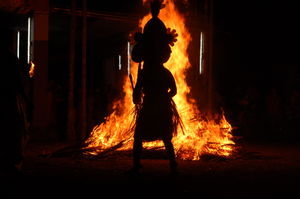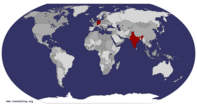Advertisement
Published: February 14th 2008

 Fiery form
Fiery form
The ferocious of all Padayani forms, Kalan Kolam, performs in front of a bonfire in Kaviyur Sri Bhagavathi templeRed eyes and white fangs are everywhere. Deft artists paint terrifying patterns on pieces of spathe spread all over the courtyard, car porch and living room. Santhosh Kaviyur led me through the kitchen door into the house to meet the host, Mohan, who quickly invited us to dinner with the artists. The family has had an offering to sponsor this year’s Padayani at the Kaviyur Sri Bhagavathi Temple.
Mohan’s mother, wife and daughters are busy taking care of the guests. It’s already past 9 in the night and any time the performers will be here to take the masks and paraphernalia to the temple. While corporate houses vie with each other to sponsor Padayani in Kadammanitta and Othara, local families have always been the patrons of this folk art in Kaviyur. The rite’s sponsorship is already booked for the next few years.
Southern Kerala’s Padayani calendar starts with Kaviyur under the watchful eyes of Pullad Gopalan Nair. The veteran is pleased with the youngsters for forming a kalari (gymnasium) for practising the ancient art. “We have been keeping alive the tradition all these years. It’s fortunate that the new generation shows a keen interest in the art form. Enjoy

 The goddess personified
The goddess personified
The Bhairavi Kolam, revered as the goddess presiding over the temple, is a herculean performance with its massive mask.it,” he tells me as Santhosh, his former disciple, introduces me.
Down the road, a bonfire is lit in the temple courtyard, where the performance would be held. The fire, lit from the temple lamp, symbolizes the divinity which would watch over the rites till the first light of the sun falls. The percussion starts as the contingent of performers set out to Mohan’s house. Raghavan Nair’s magical fingers on thappu, a unique leather drum, give an out-of-the-world charm to the ritualistic air.
The village road is alight from a couple of dry fronds in flames. Two men who have harnessed palm horses to their waists dance in front of the torchbearers. The contingent is coming back. People come out of the houses on either side of the road to bow to the massive masks made of spathe. The largest one is made of 64 pieces. In Othara, the miraculous performance would see a 1001-piece mask brought to the turf on wheels.
Tipsy men come out of their holes to greet the procession. They have been celebrating the culmination of the ten-day village festival, which ends tomorrow. When I declined the invitation to share a bottle of

 Gang of demons
Gang of demons
The Marutha, carrying a winnow and stick, performs with a dozen other smaller versions. brandy, one of them sang about revellers going to usher in the divine masks and falling headlong on the way. It was from a Padayani song. “You should drink to enjoy Padayani in all its splendour,” he said.
Nine men in three ranks, with the leader sounding a cymbal, step to the rhythm of thappu. Then the entire gang of Padayani artistes gets on the turf. They dance in two circles round a bronze lamp. Thavadi and koladi are just warm-up. The performers, with a red cloth tied over white dhoti, are getting ready for an exhausting night. For two months, Bhadrakali temples in this region bound by the Pampa River will come alive with dancing men in ferocious masks.
As with all Hindu customs, Ganapati kicks off the performance. Ganapati, Pakshi, Pishachu, Madan and Marutha are known as the panchakolam (five masks).
Two artistes with long beaks cut out of areca bark and wings made of green frond appear. The birds fly round the bonfire until their experienced helpers get them out of the turf. The bouncers have a hectic time controlling the dancers in trance. After Pakshi Kolam, comes the Marutha in a black mask.

 The culminating Kalan
The culminating Kalan
The Kalan Kolam, the ferocious of all the Padayani avatars, is inspiring as well as terrifying.As Marutha continues his dance of joy, over a dozen less-decorated Maruthas join him. The turf is full of men and boys leaping forth to the rhythm of the thappu.
Bhairavi Kolam or mask is already fitted on the head of the next performer, who assumes gigantic proportions in the terrifying attire. Firecrackers notify the Bhairavi’s arrival. Each performer is ushered in to the turf accompanied by the rhythm of chenda, the common percussion instrument in Kerala. Once the Kolam is on turf, thappu takes over.
Women stand up in ovation before the goddess personified. Bhairavi is Bhadrakali, who was born out of the third eye of Shiva the destroyer to kill Darikasura. After the ferocious goddess accomplished her mission, Shiva’s gang of demons had to stage a variety of performances to cool her down. But it took a caricature of herself to get Bhadrakali into a lighter mood. Whatever its mythological origin, the strange patterns the ingenuous artists draw are comically horrific.
Padayani is an amalgamation of arts. The paintings, the percussion, the poetry, the prancing, the play and even pyrotechnics. To top it all, come the comedians. Kakkarissi, the folk theatre, is a comic relief between the exhaustive performances. Half a dozen stand-up comedians don roles from day-to-day lives to give the audience a good laugh. The interactive theatre demands questions and answers from the audience.
Another Bhairavi. The artiste confidently folds his hands before the goddess in the temple, balancing the huge mask on his head. It takes real guts to take one's hands off the massive weight. It’s Mani alias Stunt Mani. His nick tells all about his heroics. Women bow to Mani knowing it’s the boy next door. In fact, Mani and his colleagues have been profaning (the Latin pro fanum stands for the place in front of the temple) the goddess. They have brought the divinity out of the temple and given her their forms.
There are no intermediaries here between men and the spirit he fears and revers, except the pulsating rhythm. As soon as Mani leaves the turf, the lights go off. Nina Bhairavi, her red mask licked by the light of the fire, takes over. Her mask has an elephant and a lion apart from the leitmotif of divine eyes, tongues and fangs. Women let out a ritualistic cry to welcome the goddess of blood.
Now comes the yakshis. A pair of Arakki Yakshis dance behind a red curtain as in a Kathakali performance. The men with their faces painted black occupy every square of the turf with their spirited dance. They dance in unison even after one of them loses his arecanut bark armour in the fierce dance. After a filler of stand-up comedy, Antara Yakshis come on stage. The green faces and the protruding eyes made of coconut shell make them more ferocious. They dance against each other, the way wolves fight.
The night is throbbing with unending rhythm and unexhausted fire. The highlight of the performance is yet to come. Before Mangala Bhairavi winds up the performance, there has to be Kalan Kolam. Organisers chide the men charged with keeping the fire alive with dried fronds. Not so fast, there is time. The raging fire calms down to burning flames.
Padayani, like Theyyam in north Kerala, is about the divine coming down among the human or rather the human rising to the divine. Performers go through rigorous training to prepare their body and mind for the tryst with divinity. Dancing flames and ferocious figures, bordering exhaustion and ecstasy, seem to belong to another world.
In the words of a French researcher, who played Marutha in Kadammanitta a few years ago, the rite is an attempt at exerting physical limit. “I came out of the kalam without the sensation of being a Hindu god-like icon (there are so many tricky interpretations of the Padayani cult), but instead, with the physical - quite joyful - feeling of being a part of the Padayani gang,” Marc Lambert writes in a website featuring Padayani.
“The dance lasts about 20 minutes…. I was shouting with the others, following them in a new circle pattern. I could feel at the same time the cool arecanut bark of my face and the elasticity of the earth under my feet. The fact that one is wearing a mask while dancing is special, you cannot see the sides, and you tend to concentrate more on something internal,” writes Lambert in his thesis ‘Ethnoscenology of Padayani - the body at the borders of imagination’, submitted at the University of Vincennes, Paris in April 2004.
But no avatar is as awe-inspiring as Kalan Kolam. Sleeping children are goaded awake by their yawning sisters. Men who retreated for a quick nap beneath the banyan tree are back. Under another banyan tree in a corner of the temple compound, the Kalan is ready for the invasion. Torches are lit and firecrackers sent into the still dark sky. Kalan hurries to the centre stage, preceded by a torchbearer and half a dozen helpers. He already seems to be in a trance, bowing before the goddess and playing with fire.
Kalan is made to sit on a stool near the singers. He sways to the rhythm. Now and then, he darts a fierce gaze at the spectators surrounding him. As the song gains pace, he stands on the stool. Then he jumps high and lands on terra firma. He is in form. A helper, the erstwhile Marutha, is always in service, blocking Kalan from the fire and changing his extinguished torch.
Then Kalan and his aides scoot off to the darkness. He has gone to seek the blessings of the goddess in her original abode - an ancient house near the temple. After a few minutes he runs back to continue the draining dance. He goes around the temple. Now the helper needs help. They have a tough time removing the torch from the Kalan. But he refuses to part with the sword, with which he hacks off his green-frond dress. Finally, he is overpowered and taken off the turf, his feet still dancing in the air to the wild rhythm.
It’s almost dawn. The time has come for the finale. Mangala Bhairavi, with a smaller mask, comes on stage. After the outstanding performance of Kalan, everyone is wide awake. Mangala Bhairavi rises to the occasion, culminating the spirit of the night. Even if you miss the entire night, the last two avatars make up for it.
Mohan and family give dakshina (remuneration/offering) to the performers. The men, who have removed the masks and face paint, receive brand new dhotis. Everyone from the masters to the players to the helpers and workers are entitled to their pay after a hectic night. The day was already breaking when we started the bike in search of a cup of hot coffee.
Advertisement
Tot: 0.131s; Tpl: 0.012s; cc: 11; qc: 57; dbt: 0.1011s; 1; m:domysql w:travelblog (10.17.0.13); sld: 1;
; mem: 1.2mb









